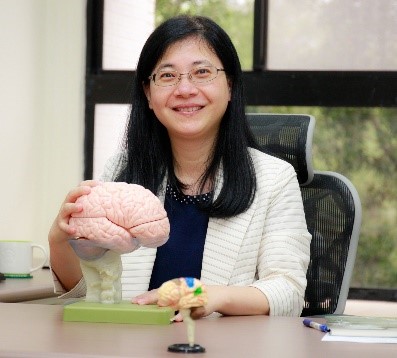瀏覽人次:
10565
幽默與創意腦神經實驗室
實驗室簡介本實驗室是由陳學志老師領導,發展方向包含眼動、ERP實驗與fMRI研究。包含創造力與幽默兩大主題。
研究設備
使用研究設備包含本系上的SR Eyelink 2000 眼球追蹤儀 (位在620室)、Tobii X120 眼球追蹤儀 (位在618-1室)與Neuroscan公司生產的SymAmp2系統 (位在628室)。 fMRI研究的儀器則與國立政治大學「台灣心智科學腦造影中心」或國立台灣大學「身體、心靈與文化整合影像研究中心」的合作。
研究團隊
 |
姓名:陳學志 職稱:教授 授課領域:認知心理學、幽默心理學、認知與情緒、實驗技術 |
 |
姓名:詹雨臻 職稱:副教授 研究方向:幽默、認知與情緒、fMRI |
 |
姓名:吳清麟 職稱:副教授 研究方向:創造力、問題解決、幽默 |
 |
姓名:戴汝卉 職稱:博士後研究員 研究方向:幽默、fMRI |
 |
姓名:曾千芝 職稱:博士後研究員 研究方向:頓悟性問題解決、眼動、識字學習 |
 |
姓名:蔡孟寧 職稱:博士生兼任助理 研究方向:幽默 |
 |
姓名:張益慈 職稱:博士生兼任助理 研究方向:幽默認知神經機制、語意處理事件相關電位 |
 |
姓名:邱靜玟 職稱:專任助理 研究方向:視覺注意、眼動、發展遲緩 |
 |
姓名:蔣依潔 職稱:專任助理 研究方向:組織行為、組織領導、情緒 |
研究成果
一、眼動研究
呂昕頤、詹雨臻*、陳學志(2019,6月)。笑話中歧義與推論歷程之眼動研究。教育心理學報,50(4),587-609。DOI:10.6251/BEP.201906_50(4).0002(TSSCI/SCOPUS)[Lu, H. I., *Chan, Y. C., & Chen, H. C. (Accepted). Ambiguity and inference processing in verbal jokes: Analyses of eye movement. Bulletin of Educational Psychology, 50(4), 587-609. (TSSCI/SCOPUS)][PDF]
Huang, P. S., Liu, C. H. & *Chen, H. C. (2019, January). Examining the Applicability of Representational Change Theory for Remote Associates Problem Solving with Eye Movement Evidence. Thinking Skills and Creativity, 31, 198-208. doi: 10.1016/j.tsc.2018.12.001 (SSCI, IF = 1.333, 120/239 in Education and Educational Research, Q3) [PDF]
Huang, P. S., & *Chen, H. C. (2016). Gender differences in eye movement in solving text-and-diagram science problems. International Journal of Science and Mathematics Education, 14, 327-346. doi: 10.1007/s10763-015-9644-3 (SSCI, IF=1.474, 70/235 in Education & Educational Research, Q2)[PDF]
俞勝皓、陳學志、林慧麗*(2018)。以眼動儀探討罹患自閉症類群障礙症之兒童對自然情境圖片中社會訊息之凝視型態:ASD自然情境圖片眼動研究,特殊教育研究學刊,43(2),65-92。doi: 10.6172/BSE.201807_43(2).0003(TSSCI)。[Yu, S. H., Chen, H. C., & *Lin, H. L. (2018). Investigating Gaze Pattern of Children with Autism Spectrum Disorder toward Social Information in Naturalistic Pictures with Eye Tracker. Bulletin of Special Education, 43(2), 65-92. doi: 10.6172/BSE.201807_43(2).0003(TSSCI)] [PDF]
劉耿良、顧維倫、陳學志、楊宗仁、林慧麗*(2016)。自閉症障礙兒童/青年之臉孔情緒辨識與眼神追蹤眼動表現的關聯性研究。臨床心理學刊,10(1),1-16。doi: 10.6550/ACP.1001.001. [Liu, G. L., Ku, W. L., Chen, H. C., Yang, T. R., & Lin H. L.* (2016). Eye-Movement Behaviors of Facial Expression Recognition and Gaze Following in Children and Youngsters with Autistic Spectrum Disorders: Do the Two Tasks Correlate. Archives of Clinical Psychology, 10(1), 1-16. (ACI)] [PDF]
Tseng, C. C., Chen, C. H., *Chen, H. C., Sung, Y. T., & Chang, K. E. (2014). Verification of the dual factors theory with eye movements during a matchstick arithmetic insight problem. Thinking Skills and Creativity, 13,129-140. doi: 10.1016/j.tsc.2014.04.004 (SSCI, IF = 1.461, 35/224 in “Education & Educational research”, Q1) [PDF]
蘇雅靜、鄭昭明*、陳學志(2014)。笑話的逆溯推論歷程:以眼動資料為證。中華心理學刊,56(1),83-95。doi:10.6129/CJP.20130410b(TSSCI/ACI)[Su, Y. C., Cheng, C. M., & Chen, H. C. (2014). The backward inference processing of jokes: Evidence from eye movement. Chinese Journal of Psychology, 56(1), 83-95. doi:10.6129/CJP.20130410b (TSSCI/ACI)] [PDF]
二、ERP研究
Chang, Y. T.; Ku, L. C., Wu, C. L., & *Chen, H. C. (2019, February). Event-Related Potential (ERP) Evidence for the Differential Cognitive Processing of Semantic Jokes and Pun Jokes. Journal of Cognitive Psychology, 31(2), 131-144. doi: 10.1080/20445911.2019.1583241 (SSCI, IF=1.378, 66/85 in experimental psychology, Q4)[PDF] Chang, Y. T., Ku, L. C., & *Chen, H. C. (2018). Sex differences in humor processing: An event-related potential study. Brain and Cognition, 120, 34-42. doi: 10.1016/j.bandc.2017.11.002 (SSCI, IF =2.547, Ranking of Experimental Psychology: 25/85, Q2) [PDF]
Ku, L. C., Feng, Y. J., Chan, Y. C., Wu, C. L., *Chen, H. C. (2017). A re-visit of three-stage humor processing with readers' surprise, comprehension, and funniness ratings: An ERP study. Journal of Neurolinguistics, 42, 49-62. doi: 10.1016/j.jneuroling.2016.11.008 (SSCI, IF=1.547, 36/181 in Linguistics, Q1) [PDF]
Chang, L. Y., Stafura, J. Z., Rickles, B., Chen, H. C., & *Perfetti, C. A. (2015). Incremental learning of Chinese orthography: ERP indicators of animated and static stroke displays on character form and meaning acquisition. Journal of Neurolinguistics, 33, 78-95. doi: 10.1016/j.jneuroling.2014.09.001 (SSCI, IF = 1.296, 34/182 in Linguistics, Q1) (SCIE, IF = 1.296, 221/256 in Neurosciences, Q4) [PDF]
Feng, Y. J., Chan, Y. C., *Chen, H. C. (2014). Specialization of neural mechanisms underlying the three-stage model in humor processing: An ERP study. Journal of Neurolinguistics, 32, 59-70. doi: 10.1016/j.jneuroling.2014.08.007 (SSCI, IF = 1.489, 21/172 in Linguistics, Q1) (SSCI, IF = 1.489, 206/252 in Neurosciences, Q4) [PDF]
三、fMRI研究
郭靜姿、陳學志、梁庚辰、高淑芬、吳清麟*(2019,5月)。數理資優大腦白質網路結構分析之研究。教育心理學報,50(3),389-406。(TSSCI/SCOPUS)[Kuo, C. C., Chen, H. C., Liang, K. C., Kao, S. S. F., & Wu, C. L. (2019). White-matter structural connectivity underlying mathematically and scientifically talent. Bulletin of Educational Psychology, 50(3), 389-406. (TSSCI/SCOPUS)] [PDF]
*Chan, Y. C., Hsu, W. C., Liao, Y. J., Chen, H. C., Tu, C. H., & Wu, C. L. (2018, October). Appreciation of different styles of humor: An fMRI study. Scientific Reports, 8(15649), 1-12. doi: 10.1038/s41598-018-33715-1 (SCI, IF = 4.122, 12/64 in Multidisciplinary Sciences, Q1) [PDF]
Wu, C. L., Zhong, S., Chan, Y. C., *Chen, H. C., & He, Y. (2018, September). White-matter structural connectivity in relation to humor styles: An exploratory study. Frontiers in Psychology, 9(1654), 1-9. doi: 10.3389/fpsyg.2018.01654 (SSCI, IF = 2.089, 39/135 in Multidisciplinary Psychology Q2.) [PDF]
Dai, R. H., *Chen, H. C., Chan, Y. C., Wu, C. L., Zuo, S. L., Li, P., & Hu, J. F. (2017). To resolve or not to resolve, that is the question: the dual-path model of incongruity resolution and absurd verbal humor by fMRI. Frontiers in Psychology, 8, 498. doi: 10.3389/fpsyg.2017.00498 (SSCI, IF = 2.089, 39/135 in Multidisciplinary Psychology, Q2.) [PDF]
*Chan, Y. C., Liao, Y. J., Tu, C. H., & *Chen H. C. (2016). Neural Correlates of Hostile Jokes: Cognitive and Motivational Processes in Humor Appreciation. Frontiers in Human Neuroscience, 10, 527. doi:10.3389/fnhum.2016.00527 (SCIE, IF = 3.209, 17/77 in Psychology, Q1) [PDF]
Wu, C. L., Zhong, S. Y., *Chen, H. C. (2016). Discriminating the Difference between Remote and Close Association with Relation to White-Matter Structural Connectivity. PLoS One, 11(10), e0165053. doi: 10.1371/journal.pone.0165053 (SSCI, IF = 2.806, 15/64 in Multidisciplinary Sciences, Q1) [PDF]
Wu, C. L., Zhong, S. Y., Chan, Y. C., *Chen, H. C., Gong, G. L. He, Y., Li, P. (2016). White-matter structural connectivity underlying human laughter-related traits processing. Frontiers in Psychology, 7, 1637. doi: 10.3389/fpsyg.2016.01637 (SSCI, IF = 2.321, 33/129 in “Multidisciplinary Psychology”, Q2) [PDF]
Wu, Q. L., Chan, Y. C., Lavallee, J. P., *Chen, H. C., Chang, K. E., & Sung, Y. T. (2013). Processing Chinese hand-radicals activates the medial frontal gyrus: A functional MRI investigation. Neural Regeneration Research, 8(20), 1837-1843. doi: 10.3969/j.issn.1673-5374.2013.20.002 (SCIE, IF = 0.234, 245/252 in “Neurosciences”, Q4) [PDF]
Chan, Y. C., Chou, T. L., *Chen, H. C., Yeh, Y. C., Lavallee, J. P., Liang, K. C., & Chang, K. E. (2013). Towards a neural circuit model of verbal humor processing: An fMRI study of the neural substrates of incongruity detection and resolution. NeuroImage, 66, 169-176. doi:10.1016/j.neuroimage.2012.10.019. (SCIE, IF = 6.132, 5/122 in “Radiology, Nuclear Medicine & Medical Imaging”, Q1) [PDF]
Chan, Y. C., Chou, T. L., *Chen, H. C., & Liang, K. C. (2012). Segregating the comprehension and elaboration process of verbal jokes: An fMRI study. NeuroImage. 61(4), 899-906. doi: 10.1037/a0026241 (SCIE, IF = 6.252, 5/122 in “Radiology, Nuclear Medicine & Medical Imaging”, Q1) [PDF]


